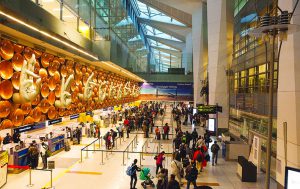BLOOMBERG
India will spend about 980 billion rupees ($12 billion) over the next two years on airports, with airline orders for hundreds of new planes to meet resurgent travel demand putting pressure on existing infrastructure.
The world’s fastest-growing aviation market aims to boost the number of airports to 220 by 2025 from the current 148, for which private builders will invest about $9 billion and state-run Airports Authority of India will bring the rest. It involves greenfield projects, new terminals and the renovation of existing facilities, including former military airfields left over from colonial times.
Though the entire country of 1.42 billion people has a fleet of only some 700 aircraft — United Airlines flies more — existing airports in major cities such as Delhi and Mumbai are running out of parking and landing slots.
The move comes as India asserts itself more broadly on the global stage, buoyed by a rising consumer base and growth in the $3.2 trillion economy on track to exceed China’s. The country has already been making its mark in aviation, with Air India Ltd last month announcing the biggest deal in commercial aviation history. Boeing and Airbus SE have been sourcing parts from India for years.
India wants to be a powerhouse in air transport, according to Civil Aviation Minister Jyotiraditya Scindia, who kicks off the three-day Capa India Aviation Summit. Boeing forecasts India’s passenger traffic will grow at a rate of nearly 7% annually, compared with 4.9% in China from 2022 through 2041.
“The growth in aviation infrastructure will bring a huge amount of economic upside and new airports will improve the quality of life for most people partly because of bad road infrastructure and slow trains in India,†said Jayant Mukhopadhaya, researcher at the International Council of Clean Transportation.
Prime Minister Narendra Modi wants to make India a world-class connecting hub as well as a destination for tourists and businesses. Linking smaller cities by air is part of his development agenda.
Air India, owned by the nation’s largest conglomerate Tata Group, has ordered 470 aircraft, while IndiGo, the nation’s No. 1 airline, is expected to place a larger order. Others are beefing up their fleets as well.
With the new acquisitions, India is trying to catch up with bigger aviation markets like China. Data from Cirium shows that Asia’s third-largest economy has more than 1,400 aircraft on order, including letters of intent that are less firm than outright purchase. That’s almost twice as many as in China, which seeks to almost double its airports to 450 by 2035. China currently operates a significantly larger fleet than India.
India wants to have more than 90 carbon-neutral airports by 2024, a difficult challenge considering only two such airports exist now, in New Delhi and southern port city of Kochi.
 The Gulf Time Newspaper One of the finest business newspapers in the UAE brought to you by our professional writers and editors.
The Gulf Time Newspaper One of the finest business newspapers in the UAE brought to you by our professional writers and editors.
